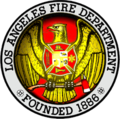Los Angeles Fire Department
Los Angeles Fire Department (LAFD) is a full-spectrum life safety agency protecting more than four million people who live, work, and play in America's second largest city. It is one of the largest municipal fire departments in the United States, with approximately 3,500 firefighters and paramedics.
History
The LAFD's history dates back to the year 1886, when the department was officially formed. Prior to this, firefighting services were provided by volunteer fire brigades and private fire insurance companies. The transition to a professional fire service was driven by the growing needs of the rapidly expanding city.
Organization
The department is organized into several bureaus, each headed by a Deputy Chief. These bureaus include Operations, which is responsible for firefighting, emergency medical services (EMS), and special operations such as urban search and rescue; Prevention, which oversees fire safety inspections and public education; and Support Services, which handles logistics, maintenance, and supply.
Operations
The Operations Bureau is the largest and most visible part of the LAFD, with firefighters stationed across the city ready to respond to fires, medical emergencies, and other incidents. The department operates a fleet of fire engines, ladder trucks, ambulances, and specialized apparatus.
Emergency Medical Services
A significant portion of the LAFD's calls are for medical emergencies. The department provides rapid response and advanced life support services, with all firefighters trained as either Emergency Medical Technicians (EMTs) or Paramedics.
Special Operations
The LAFD is equipped to handle a wide range of special operations, including hazardous materials (HazMat) incidents, urban search and rescue (USAR), and water rescues. These specialized teams are highly trained and equipped with specialized gear to tackle complex emergencies.
Fire Prevention and Safety Education
The Prevention Bureau plays a critical role in reducing fire risks through inspections, code enforcement, and public education programs. The LAFD also works closely with the community to promote fire safety and preparedness.
Challenges and Innovations
The LAFD faces numerous challenges, including wildfires, which are a significant threat due to Los Angeles' geography and climate. The department has adopted innovative strategies and technologies, such as predictive analytics and drones, to enhance its firefighting and emergency response capabilities.
Community Involvement
Community engagement is a key aspect of the LAFD's mission. The department offers various programs and initiatives to educate the public about fire safety and emergency preparedness, including the Community Emergency Response Team (CERT) program.
Conclusion
The Los Angeles Fire Department is a vital institution dedicated to protecting life, property, and the environment in one of the nation's most populous and dynamic cities. Through its commitment to excellence, innovation, and community service, the LAFD continues to meet the challenges of the 21st century.
This article is a Public safety-related stub. You can help WikiMD by expanding it!
Transform your life with W8MD's budget GLP-1 injections from $125.
W8MD offers a medical weight loss program to lose weight in Philadelphia. Our physician-supervised medical weight loss provides:
- Most insurances accepted or discounted self-pay rates. We will obtain insurance prior authorizations if needed.
- Generic GLP1 weight loss injections from $125 for the starting dose.
- Also offer prescription weight loss medications including Phentermine, Qsymia, Diethylpropion, Contrave etc.
NYC weight loss doctor appointments
Start your NYC weight loss journey today at our NYC medical weight loss and Philadelphia medical weight loss clinics.
- Call 718-946-5500 to lose weight in NYC or for medical weight loss in Philadelphia 215-676-2334.
- Tags:NYC medical weight loss, Philadelphia lose weight Zepbound NYC, Budget GLP1 weight loss injections, Wegovy Philadelphia, Wegovy NYC, Philadelphia medical weight loss, Brookly weight loss and Wegovy NYC
|
WikiMD's Wellness Encyclopedia |
| Let Food Be Thy Medicine Medicine Thy Food - Hippocrates |
Medical Disclaimer: WikiMD is not a substitute for professional medical advice. The information on WikiMD is provided as an information resource only, may be incorrect, outdated or misleading, and is not to be used or relied on for any diagnostic or treatment purposes. Please consult your health care provider before making any healthcare decisions or for guidance about a specific medical condition. WikiMD expressly disclaims responsibility, and shall have no liability, for any damages, loss, injury, or liability whatsoever suffered as a result of your reliance on the information contained in this site. By visiting this site you agree to the foregoing terms and conditions, which may from time to time be changed or supplemented by WikiMD. If you do not agree to the foregoing terms and conditions, you should not enter or use this site. See full disclaimer.
Credits:Most images are courtesy of Wikimedia commons, and templates, categories Wikipedia, licensed under CC BY SA or similar.
Contributors: Prab R. Tumpati, MD












